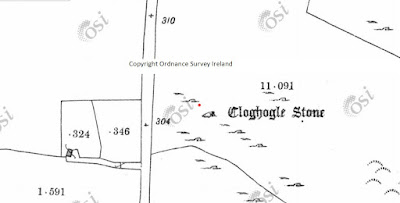Scregg Passage Tomb Roscommon
Set amidst the pastoral and wonderfully bucolic rural heartland of Roscommon is a prehistoric Neolithic feature which at first sight can be easily mistaken for a Portal Dolmen.
This feature is Scregg Passage Tomb. It is described as a Megalithic Passage Tomb on the Irish Sites and Monuments Record.
Whether the antiquity at Scregg is in actual fact a Passage Tomb may be open to interpretation.
Upon superficial examination the tomb has several features including its elevation, possible linear structure and partial surrounding mound and Kerbstones which could indicate that it is indeed a Rectilinear Passage tomb.
The end of what is presumed to be the Passage Tomb stands today atop the mound as several upright orthostats with a Capstone.
This is the part of the tomb which bears a resemblance and can be mistaken for a Portal Dolmen.
A large sunken area on the periphery of the mound may indicate a partial chamber collapse, a once existing additional Cist or a simple field clearance. It's difficult to interpret.
There is always the possibility that Scregg is the remains of some type of Gallery Grave.
The widespread Wedge Tomb gallery type grave usually found in great numbers throughout northwest Ireland were probably often covered with earthen mounds and possibly occasionally in other instances a "Cairn" built mound of stone.
Both of these types of coverings on Wedge Tombs in Ireland today are missing.
The coverings have been weathered away if earthen or been removed and reused in the case of loose stone.
It is therefor possible that many Irish Field Monuments of the late Neolithic and early Bronze age period may have once existed in the landscape laid out in a fashion we are unaccustomed to.
What is conspicuously absent from the Irish megalithic landscape are the various Long and Ovate or Oblate elliptical style Barrows of our nearest neighbor Britain which itself is dotted with a multitude of "Long Barrows".
There is no logical reason that springs to mind as to why Long Barrows would not have existed simultaneously both here in Ireland and in Britain.
Indeed circumstance and evidence of the existing prehistoric tradition would suggest that it were otherwise unlikely so where have Ireland's Long Barrows gone?
As per the old cliché, absence of evidence is not evidence of absence.
To speculate here today perhaps Scregg was something altogether different from the Passage Tomb it is ascribed as being. Speculation aside it is a beautiful place and a beautiful site to visit.
Probably the most unusual thing about Roscommon is that it's not Galway.
What I mean by that is that if you mention Galway it has connotations of sweeping landscapes and flocks of tourists.
Stocky Connemara Sheep and a vast rural field network of beautifully flowing and criss-cross Drystone walls.
Galway is percieved as evocative, world renowned and often visited.
You'll never hear tell of the multitude of people off to visit Roscommon and check out the Fuerty slabs.
Or of those seeking out the Castlestrange Stone, a beautiful and rare piece of La Tené artistry.
Of the hordes overflowing out of Roscommon Castle and of the tourists flocking to see the O'Connor Tomb and its Gallowglass Weepers.
Or the people queueing up to see Nellie's rock, the Rindoon medieval peninsula nor the Clay Pipe museum of Knockcroghery.
This area of Roscommon is to my mind as, and if not more, beautiful, than anywhere in Galway. Perhaps the Roscommon tourist board should use that tag as a catchphrase.
"It's not Galway".
Historic OSI mapping shows the Passage Tomb at Scregg named as Cloghogle Stone.
.jpg)
.jpg)
.jpg)
.jpg)
.jpg)
.jpg)
.jpg)
.jpg)
.jpg)
.jpg)
.jpg)
